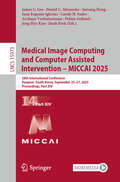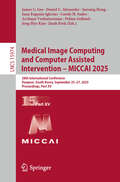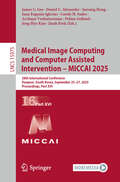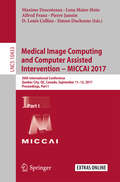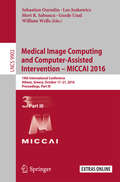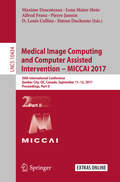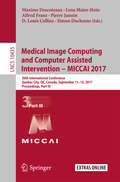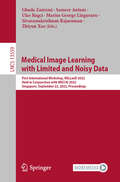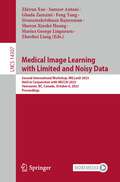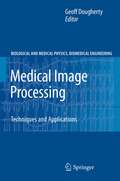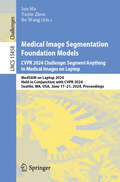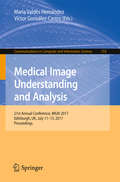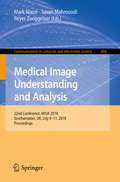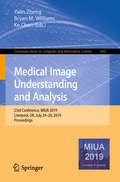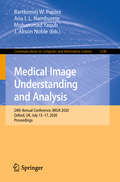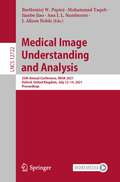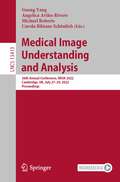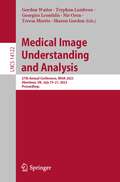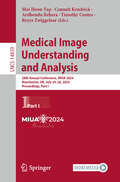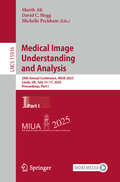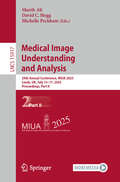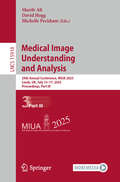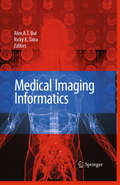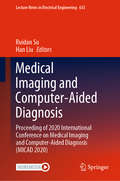- Table View
- List View
Medical Image Computing and Computer Assisted Intervention – MICCAI 2025: 28th International Conference, Daejeon, South Korea, September 23–27, 2025, Proceedings, Part XIV (Lecture Notes in Computer Science #15973)
by Daniel C. Alexander Archana Venkataraman James C. Gee Polina Golland Carole H. Sudre Jaesung Hong Juan Eugenio Iglesias Jong Hyo Kim Jinah ParkThe 16-volume set LNCS 15960 - 15975 constitutes the refereed proceedings of the 28th International Conference on Medical Image Computing and Computer Assisted Intervention, MICCAI 2025, which took place in Daejeon, South Korea, during September 23–27, 2025. The total of 1027 papers included in the proceedings was carefully reviewed and selected from 3447 submissions. They were organized in topical parts as follows: Part I, LNCS Volume 15960: Multimodal Fusion and Contextual Reasoning in Medical Imaging Part II, LNCS Volume 15961: Surgical Navigation, Scene Understanding, and Video Modeling Part III, LNCS Volume 15962: Learning and Augmented Reality for Surgical and Endoscopic Applications (I) Part IV, LNCS Volume 15963: Learning and Augmented Reality for Surgical and Endoscopic Applications (II) Part V, LNCS Volume 15964: Graph-Based Methods in Medical Imaging Part VI, LNCS Volume 15965: Datasets and Methods for Image Quality Enhancement Part VII, LNCS Volume 15966: Trustworthy and Responsible AI for Medical Imaging Part VIII, LNCS Volume 15967: Multimodal Learning for Diagnosis, Risk Prediction, and Survival Analysis Part IX, LNCS Volume 15968: Core Techniques in Medical Imaging: Segmentation, Registration, Synthesis, Reconstruction, and Other Emerging Methods (I) Part X, LNCS Volume 15969: Core Techniques in Medical Imaging: Segmentation, Registration, Synthesis, Reconstruction, and Other Emerging Methods (II) Part XI, LNCS Volume 15970: Core Techniques in Medical Imaging: Segmentation, Registration, Synthesis, Reconstruction, and Other Emerging Methods (III) Part XII, LNCS Volume 15971: Core Techniques in Medical Imaging: Segmentation, Registration, Synthesis, Reconstruction, and Other Emerging Methods (IV) Part XIII, LNCS Volume 15972: Adapting Foundation Models for Medical Imaging: LLMs, VLMs, and Cross-Domain Generalization (I) Part XIV, LNCS Volume 15973: Adapting Foundation Models for Medical Imaging: LLMs, VLMs, and Cross-Domain Generalization (II) Part XV, LNCS Volume 15974: Adapting Foundation Models for Medical Imaging: LLMs, VLMs, and Cross-Domain Generalization (III) Part XVI, LNCS Volume 15975: Statistical Techniques in Medical Imaging: Causality, Imputation, Weak Supervision, and Other Methods
Medical Image Computing and Computer Assisted Intervention – MICCAI 2025: 28th International Conference, Daejeon, South Korea, September 23–27, 2025, Proceedings, Part XV (Lecture Notes in Computer Science #15974)
by Daniel C. Alexander Archana Venkataraman James C. Gee Polina Golland Carole H. Sudre Jaesung Hong Juan Eugenio Iglesias Jong Hyo Kim Jinah ParkThe 16-volume set LNCS 15960 - 15975 constitutes the refereed proceedings of the 28th International Conference on Medical Image Computing and Computer Assisted Intervention, MICCAI 2025, which took place in Daejeon, South Korea, during September 23–27, 2025. The total of 1027 papers included in the proceedings was carefully reviewed and selected from 3447 submissions. They were organized in topical parts as follows: Part I, LNCS Volume 15960: Multimodal Fusion and Contextual Reasoning in Medical Imaging Part II, LNCS Volume 15961: Surgical Navigation, Scene Understanding, and Video Modeling Part III, LNCS Volume 15962: Learning and Augmented Reality for Surgical and Endoscopic Applications (I) Part IV, LNCS Volume 15963: Learning and Augmented Reality for Surgical and Endoscopic Applications (II) Part V, LNCS Volume 15964: Graph-Based Methods in Medical Imaging Part VI, LNCS Volume 15965: Datasets and Methods for Image Quality Enhancement Part VII, LNCS Volume 15966: Trustworthy and Responsible AI for Medical Imaging Part VIII, LNCS Volume 15967: Multimodal Learning for Diagnosis, Risk Prediction, and Survival Analysis Part IX, LNCS Volume 15968: Core Techniques in Medical Imaging: Segmentation, Registration, Synthesis, Reconstruction, and Other Emerging Methods (I) Part X, LNCS Volume 15969: Core Techniques in Medical Imaging: Segmentation, Registration, Synthesis, Reconstruction, and Other Emerging Methods (II) Part XI, LNCS Volume 15970: Core Techniques in Medical Imaging: Segmentation, Registration, Synthesis, Reconstruction, and Other Emerging Methods (III) Part XII, LNCS Volume 15971: Core Techniques in Medical Imaging: Segmentation, Registration, Synthesis, Reconstruction, and Other Emerging Methods (IV) Part XIII, LNCS Volume 15972: Adapting Foundation Models for Medical Imaging: LLMs, VLMs, and Cross-Domain Generalization (I) Part XIV, LNCS Volume 15973: Adapting Foundation Models for Medical Imaging: LLMs, VLMs, and Cross-Domain Generalization (II) Part XV, LNCS Volume 15974: Adapting Foundation Models for Medical Imaging: LLMs, VLMs, and Cross-Domain Generalization (III) Part XVI, LNCS Volume 15975: Statistical Techniques in Medical Imaging: Causality, Imputation, Weak Supervision, and Other Methods
Medical Image Computing and Computer Assisted Intervention – MICCAI 2025: 28th International Conference, Daejeon, South Korea, September 23–27, 2025, Proceedings, Part XVI (Lecture Notes in Computer Science #15975)
by Daniel C. Alexander Archana Venkataraman James C. Gee Polina Golland Carole H. Sudre Jaesung Hong Juan Eugenio Iglesias Jong Hyo Kim Jinah ParkThe 16-volume set LNCS 15960 - 15975 constitutes the refereed proceedings of the 28th International Conference on Medical Image Computing and Computer Assisted Intervention, MICCAI 2025, which took place in Daejeon, South Korea, during September 23–27, 2025. The total of 1027 papers included in the proceedings was carefully reviewed and selected from 3447 submissions. They were organized in topical parts as follows: Part I, LNCS Volume 15960: Multimodal Fusion and Contextual Reasoning in Medical Imaging Part II, LNCS Volume 15961: Surgical Navigation, Scene Understanding, and Video Modeling Part III, LNCS Volume 15962: Learning and Augmented Reality for Surgical and Endoscopic Applications (I) Part IV, LNCS Volume 15963: Learning and Augmented Reality for Surgical and Endoscopic Applications (II) Part V, LNCS Volume 15964: Graph-Based Methods in Medical Imaging Part VI, LNCS Volume 15965: Datasets and Methods for Image Quality Enhancement Part VII, LNCS Volume 15966: Trustworthy and Responsible AI for Medical Imaging Part VIII, LNCS Volume 15967: Multimodal Learning for Diagnosis, Risk Prediction, and Survival Analysis Part IX, LNCS Volume 15968: Core Techniques in Medical Imaging: Segmentation, Registration, Synthesis, Reconstruction, and Other Emerging Methods (I) Part X, LNCS Volume 15969: Core Techniques in Medical Imaging: Segmentation, Registration, Synthesis, Reconstruction, and Other Emerging Methods (II) Part XI, LNCS Volume 15970: Core Techniques in Medical Imaging: Segmentation, Registration, Synthesis, Reconstruction, and Other Emerging Methods (III) Part XII, LNCS Volume 15971: Core Techniques in Medical Imaging: Segmentation, Registration, Synthesis, Reconstruction, and Other Emerging Methods (IV) Part XIII, LNCS Volume 15972: Adapting Foundation Models for Medical Imaging: LLMs, VLMs, and Cross-Domain Generalization (I) Part XIV, LNCS Volume 15973: Adapting Foundation Models for Medical Imaging: LLMs, VLMs, and Cross-Domain Generalization (II) Part XV, LNCS Volume 15974: Adapting Foundation Models for Medical Imaging: LLMs, VLMs, and Cross-Domain Generalization (III) Part XVI, LNCS Volume 15975: Statistical Techniques in Medical Imaging: Causality, Imputation, Weak Supervision, and Other Methods
Medical Image Computing and Computer Assisted Intervention − MICCAI 2017: 20th International Conference, Quebec City, QC, Canada, September 11-13, 2017, Proceedings, Part I (Lecture Notes in Computer Science #10433)
by Pierre Jannin Maxime Descoteaux Lena Maier-Hein Alfred Franz D. Louis Collins Simon DuchesneThe three-volume set LNCS 10433, 10434, and 10435 constitutes the refereed proceedings of the 20th International Conference on Medical Image Computing and Computer-Assisted Intervention, MICCAI 2017, held in Quebec City, Canada, in September 2017. The 255 revised full papers presented were carefully reviewed and selected from 800 submissions in a two-phase review process. The papers have been organized in the following topical sections: Part I: atlas and surface-based techniques; shape and patch-based techniques; registration techniques, functional imaging, connectivity, and brain parcellation; diffusion magnetic resonance imaging (dMRI) and tensor/fiber processing; and image segmentation and modelling. Part II: optical imaging; airway and vessel analysis; motion and cardiac analysis; tumor processing; planning and simulation for medical interventions; interventional imaging and navigation; and medical image computing. Part III: feature extraction and classification techniques; and machine learning in medical image computing.
Medical Image Computing and Computer-Assisted Intervention - MICCAI 2016: 19th International Conference, Athens, Greece, October 17-21, 2016, Proceedings, Part III (Lecture Notes in Computer Science #9902)
by William Wells Sebastien Ourselin Leo Joskowicz Mert R. Sabuncu Gozde UnalThe three-volume set LNCS 9900, 9901, and 9902 constitutes the refereed proceedings of the 19th International Conference on Medical Image Computing and Computer-Assisted Intervention, MICCAI 2016, held in Athens, Greece, in October 2016. Based on rigorous peer reviews, the program committee carefully selected 228 revised regular papers from 756 submissions for presentation in three volumes. The papers have been organized in the following topical sections: Part I: brain analysis, brain analysis - connectivity; brain analysis - cortical morphology; Alzheimer disease; surgical guidance and tracking; computer aided interventions; ultrasound image analysis; cancer image analysis; Part II: machine learning and feature selection; deep learning in medical imaging; applications of machine learning; segmentation; cell image analysis; Part III: registration and deformation estimation; shape modeling; cardiac and vascular image analysis; image reconstruction; and MR image analysis.
Medical Image Computing and Computer-Assisted Intervention − MICCAI 2017: 20th International Conference, Quebec City, QC, Canada, September 11-13, 2017, Proceedings, Part II (Lecture Notes in Computer Science #10434)
by Pierre Jannin Maxime Descoteaux Lena Maier-Hein Alfred Franz D. Louis Collins Simon DuchesneThe three-volume set LNCS 10433, 10434, and 10435 constitutes the refereed proceedings of the 20th International Conference on Medical Image Computing and Computer-Assisted Intervention, MICCAI 2017, held in Quebec City, Canada, in September 2017. The 255 revised full papers presented were carefully reviewed and selected from 800 submissions in a two-phase review process. The papers have been organized in the following topical sections: Part I: atlas and surface-based techniques; shape and patch-based techniques; registration techniques, functional imaging, connectivity, and brain parcellation; diffusion magnetic resonance imaging (dMRI) and tensor/fiber processing; and image segmentation and modelling. Part II: optical imaging; airway and vessel analysis; motion and cardiac analysis; tumor processing; planning and simulation for medical interventions; interventional imaging and navigation; and medical image computing. Part III: feature extraction and classification techniques; and machine learning in medical image computing.
Medical Image Computing and Computer-Assisted Intervention − MICCAI 2017: 20th International Conference, Quebec City, QC, Canada, September 11-13, 2017, Proceedings, Part III (Lecture Notes in Computer Science #10435)
by Pierre Jannin Maxime Descoteaux Lena Maier-Hein Alfred Franz D. Louis Collins Simon DuchesneThe three-volume set LNCS 10433, 10434, and 10435 constitutes the refereed proceedings of the 20th International Conference on Medical Image Computing and Computer-Assisted Intervention, MICCAI 2017, held in Quebec City, Canada, in September 2017. The 255 revised full papers presented were carefully reviewed and selected from 800 submissions in a two-phase review process. The papers have been organized in the following topical sections: Part I: atlas and surface-based techniques; shape and patch-based techniques; registration techniques, functional imaging, connectivity, and brain parcellation; diffusion magnetic resonance imaging (dMRI) and tensor/fiber processing; and image segmentation and modelling. Part II: optical imaging; airway and vessel analysis; motion and cardiac analysis; tumor processing; planning and simulation for medical interventions; interventional imaging and navigation; and medical image computing. Part III: feature extraction and classification techniques; and machine learning in medical image computing.
Medical Image Learning with Limited and Noisy Data: First International Workshop, MILLanD 2022, Held in Conjunction with MICCAI 2022, Singapore, September 22, 2022, Proceedings (Lecture Notes in Computer Science #13559)
by Marius George Linguraru Sameer Antani Ghada Zamzmi Ulas Bagci Sivaramakrishnan Rajaraman Zhiyun XueThis book constitutes the proceedings of the First Workshop on Medical Image Learning with Limited and Noisy Data, MILLanD 2022, held in conjunction with MICCAI 2022. The conference was held in Singapore. For this workshop, 22 papers from 54 submissions were accepted for publication. They selected papers focus on the challenges and limitations of current deep learning methods applied to limited and noisy medical data and present new methods for training models using such imperfect data.
Medical Image Learning with Limited and Noisy Data: Second International Workshop, MILLanD 2023, Held in Conjunction with MICCAI 2023, Vancouver, BC, Canada, October 8, 2023, Proceedings (Lecture Notes in Computer Science #14307)
by Marius George Linguraru Sameer Antani Feng Yang Sharon Xiaolei Huang Ghada Zamzmi Sivaramakrishnan Rajaraman Zhiyun Xue Zhaohui LiangThis book consists of full papers presented in the 2nd workshop of ”Medical Image Learning with Noisy and Limited Data (MILLanD)” held in conjunction with the 26th International Conference on Medical Image Computing and Computer Assisted Intervention (MICCAI 2023).The 24 full papers presented were carefully reviewed and selected from 38 submissions. The conference focused on challenges and limitations of current deep learning methods applied to limited and noisy medical data and present new methods for training models using such imperfect data.
Medical Image Processing
by Geoff DoughertyThe book is designed for end users in the field of digital imaging, who wish to update their skills and understanding with the latest techniques in image analysis. The book emphasizes the conceptual framework of image analysis and the effective use of image processing tools. It uses applications in a variety of fields to demonstrate and consolidate both specific and general concepts, and to build intuition, insight and understanding. Although the chapters are essentially self-contained they reference other chapters to form an integrated whole. Each chapter employs a pedagogical approach to ensure conceptual learning before introducing specific techniques and "tricks of the trade". The book concentrates on a number of current research applications, and will present a detailed approach to each while emphasizing the applicability of techniques to other problems. The field of topics is wide, ranging from compressive (non-uniform) sampling in MRI, through automated retinal vessel analysis to 3-D ultrasound imaging and more. The book is amply illustrated with figures and applicable medical images. The reader will learn the techniques which experts in the field are currently employing and testing to solve particular research problems, and how they may be applied to other problems.
Medical Image Segmentation Foundation Models. CVPR 2024 Challenge: MedSAM on Laptop 2024, Held in Conjunction with CVPR 2024, Seattle, WA, USA, June 17–21, 2024, Proceedings (Lecture Notes in Computer Science #15458)
by Jun Ma Bo Wang Yuyin ZhouThis LNCS conference set constitutes the proceedings of the First Medical Image Segmentation Challenge, MedSAM on Laptop 2024, Held in Conjunction with CVPR 2024, in Seattle, WA, USA, held in June 2024. The 16 full papers presented were thoroughly reviewed and selected from the 200 submissions. This challenge aims to prompt the development of universal promotable medical image segmentation foundation models that are deployable on laptops or other edge devices without reliance on GPUs.
Medical Image Understanding and Analysis: 21st Annual Conference, MIUA 2017, Edinburgh, UK, July 11–13, 2017, Proceedings (Communications in Computer and Information Science #723)
by María Valdés Hernández Víctor González-CastroThis book constitutes the refereed proceedings of the 21st Annual Conference on Medical Image Understanding and Analysis, MIUA 2017, held in Edinburgh, UK, in July 2017.The 82 revised full papers presented were carefully reviewed and selected from 105 submissions. The papers are organized in topical sections on retinal imaging, ultrasound imaging, cardiovascular imaging, oncology imaging, mammography image analysis, image enhancement and alignment, modeling and segmentation of preclinical, body and histological imaging, feature detection and classification.The chapters 'Model-Based Correction of Segmentation Errors in Digitised Histological Images' and 'Unsupervised Superpixel-Based Segmentation of Histopathological Images with Consensus Clustering' are open access under a CC BY 4.0 license.
Medical Image Understanding and Analysis: 22nd Conference, Miua 2018, Southampton, Uk, July 9-11, 2018, Revised Selected Papers (Communications In Computer And Information Science #894)
by Mark Nixon Reyer Zwiggelaar Sasan MahmoodiThis book constitutes the refereed proceedings of the 22st Annual Conference on Medical Image Understanding and Analysis, MIUA 2018, held in Southampton, UK, in July 2018.The 34 revised full papers presented were carefully reviewed and selected from 49 submissions. The papers are organized in topical sections on liver analysis, medical image analysis, texture and image analysis, MRI: applications and techniques, segmentation in medical images, CT: learning and planning, ocular imaging analysis, applications of medical image analysis.
Medical Image Understanding and Analysis: 23rd Conference, MIUA 2019, Liverpool, UK, July 24–26, 2019, Proceedings (Communications in Computer and Information Science #1065)
by Ke Chen Yalin Zheng Bryan M. WilliamsThis book constitutes the refereed proceedings of the 23rd Conference on Medical Image Understanding and Analysis, MIUA 2019, held in Liverpool, UK, in July 2019. The 43 full papers presented were carefully reviewed and selected from 70 submissions. There were organized in topical sections named: oncology and tumour imaging; lesion, wound and ulcer analysis; biostatistics; fetal imaging; enhancement and reconstruction; diagnosis, classification and treatment; vessel and nerve analysis; image registration; image segmentation; ophthalmic imaging; and posters.
Medical Image Understanding and Analysis: 24th Annual Conference, MIUA 2020, Oxford, UK, July 15-17, 2020, Proceedings (Communications in Computer and Information Science #1248)
by Bartłomiej W. Papież Ana I. L. Namburete Mohammad Yaqub J. Alison NobleThis book constitutes the refereed proceedings of the 24th Conference on Medical Image Understanding and Analysis, MIUA 2020, held in July 2020. Due to COVID-19 pandemic the conference was held virtually. The 29 full papers and 5 short papers presented were carefully reviewed and selected from 70 submissions. They were organized according to following topical sections: image segmentation; image registration, reconstruction and enhancement; radiomics, predictive models, and quantitative imaging biomarkers; ocular imaging analysis; biomedical simulation and modelling.
Medical Image Understanding and Analysis: 25th Annual Conference, MIUA 2021, Oxford, United Kingdom, July 12–14, 2021, Proceedings (Lecture Notes in Computer Science #12722)
by Bartłomiej W. Papież Ana I. L. Namburete Mohammad Yaqub J. Alison Noble Jianbo JiaoThis book constitutes the refereed proceedings of the 25th Conference on Medical Image Understanding and Analysis, MIUA 2021, held in July 2021. Due to COVID-19 pandemic the conference was held virtually. The 32 full papers and 8 short papers presented were carefully reviewed and selected from 77 submissions. They were organized according to following topical sections: biomarker detection; image registration, and reconstruction; image segmentation; generative models, biomedical simulation and modelling; classification; image enhancement, quality assessment, and data privacy; radiomics, predictive models, and quantitative imaging.
Medical Image Understanding and Analysis: 26th Annual Conference, MIUA 2022, Cambridge, UK, July 27–29, 2022, Proceedings (Lecture Notes in Computer Science #13413)
by Michael Roberts Carola-Bibiane Schönlieb Guang Yang Angelica Aviles-RiveroThis book constitutes the refereed proceedings of the 26th Conference on Medical Image Understanding and Analysis, MIUA 2022, held in Cambridge, UK, in July 2022. The 65 full papers presented were carefully reviewed and selected from 95 submissions. They were organized according to following topical sections: biomarker detection; image registration, and reconstruction; image segmentation; generative models, biomedical simulation and modelling; classification; image enhancement, quality assessment, and data privacy; radiomics, predictive models, and quantitative imaging.Chapter “FCN-Transformer Feature Fusion for Polyp Segmentation” is available open access under a Creative Commons Attribution 4.0 International License via link.springer.com.
Medical Image Understanding and Analysis: 27th Annual Conference, MIUA 2023, Aberdeen, UK, July 19–21, 2023, Proceedings (Lecture Notes in Computer Science #14122)
by Sharon Gordon Nir Oren Gordon Waiter Tryphon Lambrou Georgios Leontidis Teresa MorrisThis book constitutes the proceedings of the 27th Annual Conference on Medical Image Understanding and Analysis, MIUA 2023, which took place in Aberdeen, UK, during July 19–21, 2023.The 24 full papers presented in this book were carefully reviewed and selected from 42 submissions. They were organized in topical sections as follows: Image interpretation; radiomics, predictive models and quantitative imaging; image classification; and biomarker detection.
Medical Image Understanding and Analysis: 28th Annual Conference, MIUA 2024, Manchester, UK, July 24–26, 2024, Proceedings, Part I (Lecture Notes in Computer Science #14859)
by Reyer Zwiggelaar Moi Hoon Yap Connah Kendrick Ardhendu Behera Timothy CootesThis two-volume set LNCS 14859-14860 constitutes the proceedings of the 28th Annual Conference on Medical Image Understanding and Analysis, MIUA 2024, held in Manchester, UK, during July 24–26, 2024. The 59 full papers included in this book were carefully reviewed and selected from 93 submissions. They were organized in topical sections as follows: Part I : Advancement in Brain Imaging; Medical Images and Computational Models; and Digital Pathology, Histology and Microscopic Imaging. Part II : Dental and Bone Imaging; Enhancing Low-Quality Medical Images; Domain Adaptation and Generalisation; and Dermatology, Cardiac Imaging and Other Medical Imaging.
Medical Image Understanding and Analysis: 28th Annual Conference, MIUA 2024, Manchester, UK, July 24–26, 2024, Proceedings, Part II (Lecture Notes in Computer Science #14860)
by Reyer Zwiggelaar Moi Hoon Yap Connah Kendrick Ardhendu Behera Timothy CootesThis two-volume set LNCS 14859-14860 constitutes the proceedings of the 28th Annual Conference on Medical Image Understanding and Analysis, MIUA 2024, held in Manchester, UK, during July 24–26, 2024. The 59 full papers included in this book were carefully reviewed and selected from 93 submissions. They were organized in topical sections as follows: Part I : Advancement in Brain Imaging; Medical Images and Computational Models; and Digital Pathology, Histology and Microscopic Imaging. Part II : Dental and Bone Imaging; Enhancing Low-Quality Medical Images; Domain Adaptation and Generalisation; and Dermatology, Cardiac Imaging and Other Medical Imaging.
Medical Image Understanding and Analysis: 29th Annual Conference, MIUA 2025, Leeds, UK, July 15–17, 2025, Proceedings, Part I (Lecture Notes in Computer Science #15916)
by Michelle Peckham David C. Hogg Sharib AliThe three-volume set LNCS 15916,15917 & 15918 constitutes the refereed proceedings of the 29th Annual Conference on Medical Image Understanding and Analysis, MIUA 2025, held in Leeds, UK, during July 15–17, 2025. The 67 revised full papers presented in these proceedings were carefully reviewed and selected from 99 submissions. The papers are organized in the following topical sections: Part I: Frontiers in Computational Pathology; and Image Synthesis and Generative Artificial Intelligence. Part II: Image-guided Diagnosis; and Image-guided Intervention. Part III: Medical Image Segmentation; and Retinal and Vascular Image Analysis.
Medical Image Understanding and Analysis: 29th Annual Conference, MIUA 2025, Leeds, UK, July 15–17, 2025, Proceedings, Part II (Lecture Notes in Computer Science #15917)
by Michelle Peckham David C. Hogg Sharib AliThe three-volume set LNCS 15916,15917 & 15918 constitutes the refereed proceedings of the 29th Annual Conference on Medical Image Understanding and Analysis, MIUA 2025, held in Leeds, UK, during July 15–17, 2025. The 67 revised full papers presented in these proceedings were carefully reviewed and selected from 99 submissions. The papers are organized in the following topical sections: Part I: Frontiers in Computational Pathology; and Image Synthesis and Generative Artificial Intelligence. Part II: Image-guided Diagnosis; and Image-guided Intervention. Part III: Medical Image Segmentation; and Retinal and Vascular Image Analysis.
Medical Image Understanding and Analysis: 29th Annual Conference, MIUA 2025, Leeds, UK, July 15–17, 2025, Proceedings, Part III (Lecture Notes in Computer Science #15918)
by Michelle Peckham David C. Hogg Sharib AliThe three-volume set LNCS 15916,15917 & 15918 constitutes the refereed proceedings of the 29th Annual Conference on Medical Image Understanding and Analysis, MIUA 2025, held in Leeds, UK, during July 15–17, 2025. The 67 revised full papers presented in these proceedings were carefully reviewed and selected from 99 submissions. The papers are organized in the following topical sections: Part I: Frontiers in Computational Pathology; and Image Synthesis and Generative Artificial Intelligence. Part II: Image-guided Diagnosis; and Image-guided Intervention. Part III: Medical Image Segmentation; and Retinal and Vascular Image Analysis.
Medical Imaging Informatics
by Ricky K. Taira Alex A.T. BuiMedical Imaging Informatics provides an overview of this growing discipline, which stems from an intersection of biomedical informatics, medical imaging, computer science and medicine. Supporting two complementary views, this volume explores the fundamental technologies and algorithms that comprise this field, as well as the application of medical imaging informatics to subsequently improve healthcare research. Clearly written in a four part structure, this introduction follows natural healthcare processes, illustrating the roles of data collection and standardization, context extraction and modeling, and medical decision making tools and applications. Medical Imaging Informatics identifies core concepts within the field, explores research challenges that drive development, and includes current state-of-the-art methods and strategies.
Medical Imaging and Computer-Aided Diagnosis: Proceeding of 2020 International Conference on Medical Imaging and Computer-Aided Diagnosis (MICAD 2020) (Lecture Notes in Electrical Engineering #633)
by Han Liu Ruidan SuThis book covers virtually all aspects of image formation in medical imaging, including systems based on ionizing radiation (x-rays, gamma rays) and non-ionizing techniques (ultrasound, optical, thermal, magnetic resonance, and magnetic particle imaging) alike. In addition, it discusses the development and application of computer-aided detection and diagnosis (CAD) systems in medical imaging. Given its coverage, the book provides both a forum and valuable resource for researchers involved in image formation, experimental methods, image performance, segmentation, pattern recognition, feature extraction, classifier design, machine learning / deep learning, radiomics, CAD workstation design, human–computer interaction, databases, and performance evaluation.
